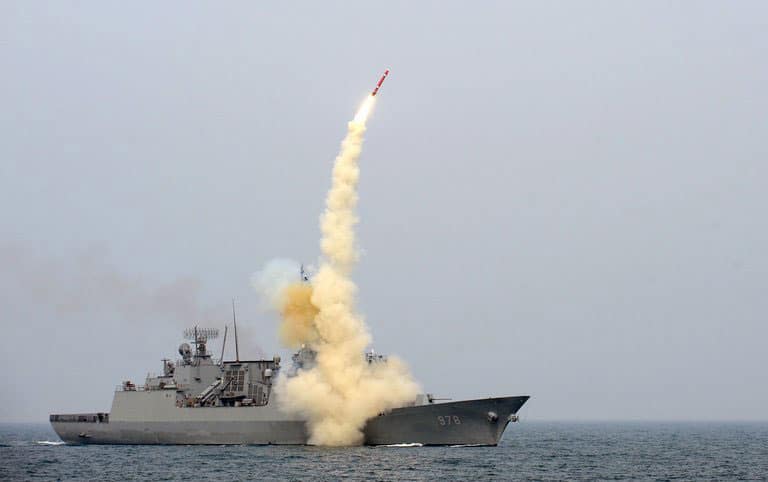The Hyunmoo-3 series is a family of short- to medium-range, land-attack cruise missiles. The Hyunmoo-3A, 3B, and 3C are currently in service, with a D variant reportedly in development. The Hyunmoo 3C, with a reach of 1,500 km, is among the longest range missiles that South Korea currently deploys.
Hyunmoo-3 at a Glance
- Originated from
- South Korea
- Possessed by
- South Korea
- Alternate names
- Cheon Ryong (‘Eagle’), Sky Dragon, Tenryu, Tainlong
- Class
- Land-attack cruise missile (LACM)
- Basing
- Road-mobile (3A, 3B); ship, submarine-based (3C)
- Length
- 6.2 m
- Diameter
- 0.53-0.60 m
- Launch weight
- 1,360 kg
- Payload
- 500 kg (3A, 3B); 450 kg (3C)
- Propulsion
- Solid-propellant booster, turbojet engine
- Range
- 500 km (3A); 1,000 km (3B); 1,500 km (3C)
- Status
- Operational
- In service
- 2006-present (3A); 2009-present (3B); 2012-present (3C)



Hyunmoo-3 Development
South Korea (ROK) likely began development of an indigenous cruise missile in the 1990s, with the initial deployments of the Hyunmoo 3A occurring in 2006. This development effort has enabled South Korea to extend the reach of its missile forces, as ROK’s ballistic missile programs are limited by US-ROK arms control agreements.1
The Hyunmoo-3 series has become a key element in South Korea’s military posture. Its longer-range strike capabilities, as well as its increased accuracy and improved bunker-busting capabilities, support both South Korea’s ‘Kill Chain’ and its ‘Korea Massive Punishment and Retaliation’ decapitation strategies against North Korean leaders.
Several reports note that the Hyunmoo-3 resembles the U.S. Tomahawk and Russian Klub/Kalibr missiles.2
The Hyunmoo-3 series was developed by the state-run Agency for Defense Development and manufactured by LIG Nex1.
Hyunmoo-3A
South Korea deployed the Hyunmoo-3A in 2006. The road-mobile, ground-launched cruise missile has a range of 500 km.3
As Anthony Cordesman notes, while the Hyunmoo-3A is capable of striking Pyongyang, its range is insufficient to reach the DPRK’s long-range missile sites like the Musadan-ri site in North Hamgyeong Province.4 This limitation likely explains why ROK soon began development of the longer-ranged 3B variant.
Hyunmoo-3B
South Korea deployed the Hyunmoo-3B in early 2009.5 With an improved range of 1,000 km, the Hyunmoo-3B was the first ground-launched cruise missile to provide ROK the capability to target all of North Korea from almost any location in South Korea.6
Like the Hyunmoo-3A, the 3B variant is road-mobile.
Hyunmoo-3C
ROK military sources say development of the ship- and submarine-based Hyunmoo-3C began in 2008, but reports indicate that testing began as early as 2006.7
The missile entered full production in 2010, and was deployed in April 2012.8
It has a range of 1,500 km.9
In addition to providing South Korea with longer-distance cruise missile capability, the Hyunmoo-3C’s sea basing adds greater flexibility to ROK missile platforms. The missile was designed to be fired from destroyers (KDX-III) or submarines (KSS-II) with vertical launch systems.10
Hyunmoo-3D/4
Development of a fourth Hyunmoo-3 variant is reportedly underway. One report indicates the Hyunmoo-3D/4 will be capable of a range of 3,000 km while carrying a 500 kg payload.11 It will likely be supersonic.12
Hyunmoo 3 Specifications
While the Hyunmoo-3 missile series developed with increasing range and accuracy, they share common elements and characteristics. Hyunmoo-3 missiles reportedly have a length of 6.2 m, body diameter of 0.53 m to 0.60 m, and launch weight of approximately 1,360 kg. The A and B variants can carry a payload of 500 kg, while the C version can carry a 450 kg warhead.13
The Hyunmoo-3 incorporates inertial navigation system, GPS, and terrain matching technology.14 The A and B variants have a CEP of approximately 3 m, and according to one military analyst, the C variant has a CEP of less than 2 m.15
All missiles within the Hyunmoo-3 series employ solid-propellant boosters and turbojet engines.16
Service History
The Hyunmoo-3A was first test fired on October 25, 2006, flying 500 km, and entered service later that year. 17 The Hyunmoo-3B entered service in early 2009.18
As the 3A and 3B variants are road-mobile, it is difficult to track their deployments.
The Hyunmoo-3C is deployed on ROK Navy KDX-III destroyers, Incheon-class frigates, and Type 214 submarines (KSS-II) with vertical launch systems.19
With a range of over 1,000 km, South Korea classifies the Hunmoo 3C as a ‘strategic weapon’ under control of the Joint Chiefs, rather than the ROK Navy.20
Footnotes
- “S.Korea’s Cruise Missile Program Revealed,” Chosunilbo, October 25, 2016, http://english.chosun.com/site/data/html_dir/2006/10/25/2006102561007.html.
- Anthony H. Cordesman, “Korean Missile Forces,” CSIS, November 7, 2016, https://csis-prod.s3.amazonaws.com/s3fs-public/publication/161108_AHC_Korean_Missile_Forces.pdf; “Cheon Ryong,” in IHS Jane’s Weapons: Naval 2016-2017, ed. David Ewing & Malcolm Fuller (United Kingdom: IHS, 2016), 17
- “South Korea: Missile,” Nuclear Threat Initiative, April 2016, http://www.nti.org/learn/countries/south-korea/delivery-systems/.
- Cordesman.
- Ibid.
- Kyle Mizokami, “This Is How South Korea Plans to Stop a Nuclear Attack from North Korea,” The National Interest, July 10, 2017, http://nationalinterest.org/blog/the-buzz/how-south-korea-plans-stop-nuclear-attack-north-korea-21472.
- Song Sang-ho, “Seoul gets long-range cruise missile: sources,” The Korea Herald, July 18, 2010, http://nwww.koreaherald.com/common_prog/newsprint.php?ud=20100718000258&dt=2; Bradley Parrett, “South Korea Works on New Missile Technology,” Aviation Week, June 1, 2012, http://aviationweek.com/awin/south-korea-works-new-missile-technology.
- “S. Korea deploys new missile capable of hitting anywhere in N. Korea,” Yonhap News Agency, April 19, 2012, http://english.yonhapnews.co.kr/national/2012/04/19/90/0301000000AEN20120419003000315F.HTML.
- Lee Tae-hoon, “Secret weapons account for 30% of LIG Nex1 sales,” The Korea Times, February 2, 2012, http://koreatimes.co.kr/www/news/nation/2012/02/113_104024.html.
- Ibid.
- Joseph Trevithick, “South Korea Tests Ballistic Missile That Can Hit Anywhere Inside North Korea,” June 23, 2017, http://www.thedrive.com/the-war-zone/11823/south-korea-tests-ballistic-missile-that-can-hit-anywhere-inside-north-korea.
- Parrett.
- “Design Characteristics of South Korea’s Ballistic and Cruise Missiles,” Nuclear Threat Initiative, November 2014, http://www.nti.org/media/pdfs/design_characteristics_of_south_korea_missiles.pdf?_=1415661529.
- “Cheon Ryong,” in IHS Jane’s Weapons: Naval 2016-2017, ed. David Ewing & Malcolm Fuller (United Kingdom: IHS, 2016), 17.
- Song Sang-ho, “Seoul gets long-range cruise missile: sources,” The Korea Herald, July 18, 2010, http://nwww.koreaherald.com/common_prog/newsprint.php?ud=20100718000258&dt=2; Cordesman.
- NTI.
- Jane’s Weapons: Naval, 16.
- Cordesman, CSIS.
- Lee Tae-hoon, The Korea Times.
- Kim Minseok and Bradley Perrett, “South Korea’s LIG Nex1 Land-Attack Missile Cleared For Service,” Aviation Week, May 8, 2017, http://aviationweek.com/defense/south-korea-s-lig-nex1-land-attack-missile-cleared-service?platform=hootsuite.